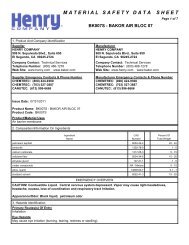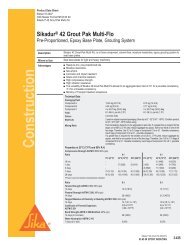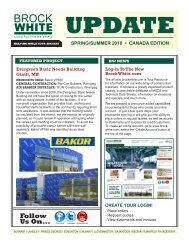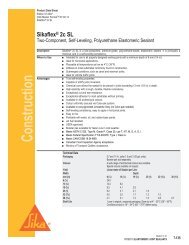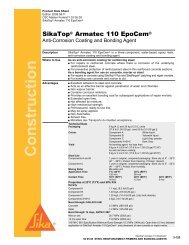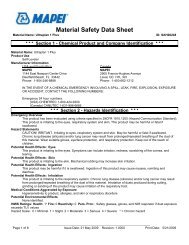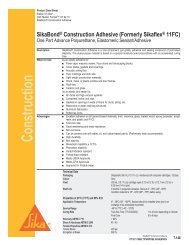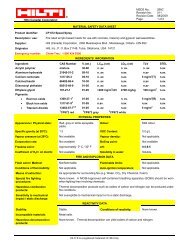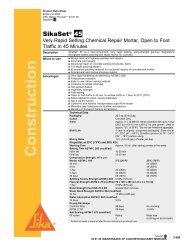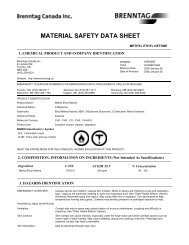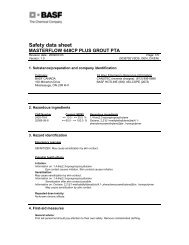Operations Manual - WSR18A - Home Depot
Operations Manual - WSR18A - Home Depot
Operations Manual - WSR18A - Home Depot
Create successful ePaper yourself
Turn your PDF publications into a flip-book with our unique Google optimized e-Paper software.
WSR 18-A<br />
Operating instructions<br />
Mode d’emploi<br />
<strong>Manual</strong> de instrucciones<br />
<strong>Manual</strong> de instruções<br />
en<br />
fr<br />
es<br />
pt
2 3<br />
4<br />
5<br />
6<br />
7
8<br />
9<br />
10
11<br />
3<br />
5<br />
1<br />
2 4
ORIGINAL OPERATING INSTRUCTIONS<br />
WSR 18‐A cordless reciprocating saw<br />
It is essential that the operating instructions<br />
are read before the power tool is operated<br />
for the first time.<br />
Always keep these operating instructions<br />
together with the power tool.<br />
Ensure that the operating instructions are<br />
with the power tool when it is given to<br />
other persons.<br />
Contents<br />
Page<br />
1. General information 1<br />
2. Description 2<br />
3. Spare parts 3<br />
4. Accessories 4<br />
5. Technical data 4<br />
6. Safety instructions 4<br />
7. Before use 8<br />
8. Operation 9<br />
9. Care and maintenance 11<br />
10. Troubleshooting 12<br />
11. Disposal 12<br />
12. Manufacturer’s warranty - tools 13<br />
1 These numbers refer to the corresponding illustrations.<br />
The illustrations can be found on the fold-out<br />
cover pages. Keep these pages open while studying<br />
the operating instructions.<br />
In these operating instructions, the designation “the<br />
power tool” always refers to the WSR 18-A cordless<br />
reciprocating saw.<br />
Parts and operating controls 1<br />
@ Blade holder<br />
; Control switch<br />
= Transport lock<br />
% Type identification plate<br />
& Battery<br />
( Forward gripping area (hand guard)<br />
) AVR contact shoe<br />
+ Saw blade<br />
en<br />
1. General information<br />
1.1 Safety notices and their meaning<br />
DANGER<br />
Draws attention to imminent danger that could lead<br />
to serious bodily injury or fatality.<br />
WARNING<br />
Draws attention to a potentially dangerous situation<br />
that could lead to serious personal injury or fatality.<br />
NOTE<br />
Draws attention to an instruction or other useful<br />
information.<br />
1.2 Explanation of the pictograms and other<br />
information<br />
Warning signs<br />
CAUTION<br />
Draws attention to a potentially dangerous situation<br />
that could lead to slight personal injury or damage to<br />
the equipment or other property.<br />
General<br />
warning<br />
Warning:<br />
electricity<br />
Warning: hot<br />
surface<br />
Warning:<br />
caustic<br />
substances<br />
1
en<br />
Obligation signs<br />
Wear eye<br />
protection<br />
Wear a hard<br />
hat<br />
Wear ear<br />
protection<br />
Wear<br />
protective<br />
gloves<br />
Location of identification data on the power tool<br />
The type designation and serial number can be found<br />
on the type identification plate on the machine or tool.<br />
Make a note of this data in your operating instructions<br />
and always refer to it when making an enquiry to your<br />
Hilti representative or service department.<br />
Type:<br />
Generation: 01<br />
Wear<br />
breathing<br />
protection<br />
Serial no.:<br />
Symbols<br />
Volts Direct current Strokes per<br />
minute<br />
Read the<br />
operating<br />
instructions<br />
before use<br />
Return waste<br />
material for<br />
recycling.<br />
Stroke rate<br />
Unlocked<br />
Locked<br />
2. Description<br />
2.1 Use of the product as directed<br />
The WSR 18-A is a cordless reciprocating saw for professional use. It is designed to be used for cutting wood,<br />
wood-like materials, metals and plastics. The power tool is suitable for use by right or left-handed persons. An<br />
ergonomically designed grip with synthetic rubber covering provides a comfortable, secure hold and makes<br />
the power tool less tiring to use.<br />
The power tool is designed for two-handed operation.<br />
Possible fields of use: Rescue services, public authorities, agriculture and forestry, construction sites,<br />
workshops, renovation, conversion and new construction, metal construction, timber construction, plumbing,<br />
heating and air conditioning system installation in which the types of cutting work listed above are carried out.<br />
Do not use the power tool to cut bricks, concrete, cellular concrete, natural stone or tiles.<br />
Do not use the power tool to cut pipes which still contain liquids.<br />
Do not saw into unknown materials.<br />
2
The power tool is designed for professional use and may be operated, serviced and maintained only by trained,<br />
authorized personnel. This personnel must be informed of any special hazards that may be encountered. The<br />
power tool and its ancillary equipment may present hazards when used incorrectly by untrained personnel or<br />
when used not as directed.<br />
To avoid the risk of injury, use only genuine Hilti accessories and insert tools.<br />
Working on materials hazardous to the health (e.g. asbestos) is not permissible.<br />
Nationally applicable industrial safety regulations must be observed.<br />
The power tool may be used only in a dry environment.<br />
Do not use the power tool where there is a risk of fire or explosion.<br />
Do not use the battery as a power source for other unspecified appliances.<br />
Observe the information printed in the operating instructions concerning operation, care and maintenance.<br />
Modification of the power tool or tampering with its parts is not permissible.<br />
en<br />
2.2 Switches<br />
Control switch<br />
Safety lock<br />
2.3 Grips<br />
Vibration-absorbing grip<br />
2.4 Items supplied as standard<br />
1 Power tool<br />
1 Operating instructions<br />
1 Hilti toolbox<br />
2.5 Li‐ion battery charge status<br />
LEDs light constantly LEDs blink Charge status C<br />
LED 1,2,3,4 - C ≧ 75 %<br />
LED 1,2,3 - 50 % ≦ C < 75 %<br />
LED 1,2 - 25 % ≦ C < 50 %<br />
LED 1 - 10 % ≦ C < 25 %<br />
- LED 1 C < 10 %<br />
- LED 1 Battery overheated<br />
3. Spare parts<br />
AVR contact shoe 1<br />
7 AVR contact shoe 408847<br />
3
4. Accessories<br />
en<br />
Saw blades<br />
Charger for Li-ion batteries<br />
Battery<br />
Battery<br />
C 4/36, C 4/36‐ACS or<br />
C 4/36‐ACS TPS<br />
B 18/2.6 Li‐ion<br />
B 18/1.6 Li‐ion<br />
with ½" connection end<br />
5. Technical data<br />
Right of technical changes reserved.<br />
Power tool WSR 18‐A<br />
Rated voltage (DC voltage)<br />
21.6 V<br />
Weight in accordance with EPTA procedure 3.8 kg (8.38 lb)<br />
01/2003<br />
Dimensions (L x W x H)<br />
492 mm (19.37") x 96 mm (3.78") x 196 mm<br />
(7.72")<br />
Stroke rate<br />
0…3,000/min<br />
Stroke 28 mm (1.1")<br />
Blade holder<br />
Keyless, for ¹/₂" standard blades<br />
Battery B 18/2.6 Li‐ion B 18/1.6 Li‐ion<br />
Rated voltage 21.6 V 21.6 V<br />
Capacity 2.6 Ah 1.6 Ah<br />
Energy capacity 56.16 Wh 34.56 Wh<br />
Weight 0.78 kg (1.72 lb) 0.48 kg (1.06 lb)<br />
Type of cell Li‐ion Li‐ion<br />
Number of cells 12 6<br />
Temperature monitoring during Yes<br />
Yes<br />
charging<br />
Temperature monitoring during<br />
discharging<br />
Yes<br />
Yes<br />
6. Safety instructions<br />
NOTE<br />
The safety rules in section 6.1 contain all general<br />
safety rules for power tools which, in accordance<br />
with the applicable standards, require to be listed in<br />
the operating instructions. Accordingly, some of the<br />
rules listed may not be relevant to this tool.<br />
6.1 General Power Tool Safety Warnings<br />
a) WARNING! Read all safety warnings and instructions.<br />
Failure to follow the warnings and instructions<br />
may result in electric shock, fire and/or<br />
serious injury. Save all warnings and instruc-<br />
4
tions for future reference. The term “power tool”<br />
in the warnings refers to your mains-operated<br />
(corded) power tool or battery-operated (cordless)<br />
power tool.<br />
6.1.1 Work area safety<br />
a) Keep work area clean and well lit. Cluttered or<br />
dark areas invite accidents.<br />
b) Do not operate power tools in explosive atmospheres,<br />
such as in the presence of flammable<br />
liquids, gases or dust. Power tools create sparks<br />
which may ignite the dust or fumes.<br />
c) Keep children and bystanders away while operating<br />
a power tool. Distractions can cause you to<br />
lose control.<br />
6.1.2 Electrical safety<br />
a) Power tool plugs must match the outlet. Never<br />
modify the plug in any way. Do not use any<br />
adapter plugs with earthed (grounded) power<br />
tools. Unmodified plugs and matching outlets<br />
will reduce risk of electric shock.<br />
b) Avoid body contact with earthed or grounded<br />
surfaces such as pipes, radiators, ranges and<br />
refrigerators. There is an increased risk of electric<br />
shock if your body is earthed or grounded.<br />
c) Do not expose power tools to rain or wet conditions.<br />
Water entering a power tool will increase<br />
the risk of electric shock.<br />
d) Do not abuse the cord. Never use the cord for<br />
carrying, pulling or unplugging the power tool.<br />
Keep cord away from heat, oil, sharp edges<br />
or moving parts. Damaged or entangled cords<br />
increase the risk of electric shock.<br />
e) When operating a power tool outdoors, use an<br />
extension cord suitable for outdoor use. Use of<br />
a cord suitable for outdoor use reduces the risk<br />
of electric shock.<br />
f) If operating a power tool in a damp location<br />
is unavoidable, use a residual current device<br />
(RCD) protected supply. Use of an RCD reduces<br />
the risk of electric shock.<br />
6.1.3 Personal safety<br />
a) Stay alert, watch what you are doing and use<br />
common sense when operating a power tool. Do<br />
not use a power tool while you are tired or under<br />
the influence of drugs, alcohol or medication.<br />
A moment of inattention while operating power<br />
tools may result in serious personal injury.<br />
b) Use personal protective equipment. Always<br />
wear eye protection. Protective equipment<br />
such as dust mask, non-skid safety shoes, hard<br />
hat, or hearing protection used for appropriate<br />
conditions will reduce personal injuries.<br />
c) Prevent unintentional starting. Ensure the<br />
switch is in the off‐position before connecting<br />
to power source and/or battery pack, picking up<br />
or carrying the tool. Carrying power tools with<br />
your finger on the switch or energising power<br />
tools that have the switch on invites accidents.<br />
d) Remove any adjusting key or wrench before<br />
turning the power tool on. A wrench or a key left<br />
attached to a rotating part of the power tool may<br />
result in personal injury.<br />
e) Do not overreach. Keep proper footing and balance<br />
at all times. This enables better control of<br />
the power tool in unexpected situations.<br />
f) Dress properly. Do not wear loose clothing or<br />
jewellery. Keep your hair, clothing and gloves<br />
away from moving parts. Loose clothes, jewellery<br />
or long hair can be caught in moving parts.<br />
g) If devices are provided for the connection of<br />
dust extraction and collection facilities, ensure<br />
these are connected and properly used. Use of<br />
dust collection can reduce dust-related hazards.<br />
6.1.4 Power tool use and care<br />
a) Do not force the power tool. Use the correct<br />
power tool for your application. The correct<br />
power tool will do the job better and safer at the<br />
rate for which it was designed.<br />
b) Do not use the power tool if the switch does not<br />
turn it on and off. Any power tool that cannot be<br />
controlled with the switch is dangerous and must<br />
be repaired.<br />
c) Disconnect the plug from the power source<br />
and/or the battery pack from the power tool<br />
before making any adjustments, changing accessories,<br />
or storing power tools. Such preventive<br />
safety measures reduce the risk of starting<br />
the power tool accidentally.<br />
d) Store idle power tools out of the reach of children<br />
and do not allow persons unfamiliar with<br />
the power tool or these instructions to operate<br />
the power tool. Power tools are dangerous in the<br />
hands of untrained users.<br />
e) Maintain power tools. Check for misalignment<br />
or binding of moving parts, breakage of parts<br />
and any other condition that may affect the<br />
en<br />
5
en<br />
power tool’s operation. If damaged, have the<br />
power tool repaired before use. Many accidents<br />
are caused by poorly maintained power tools.<br />
f) Keep cutting tools sharp and clean. Properly<br />
maintained cutting tools with sharp cutting edges<br />
are less likely to bind and are easier to control.<br />
g) Use the power tool, accessories and tool bits<br />
etc. in accordance with these instructions taking<br />
into account the working conditions and the<br />
work to be performed. Use of the power tool for<br />
operations different from those intended could<br />
result in a hazardous situation.<br />
6.1.5 Battery tool use and care<br />
a) Recharge only with the charger specified by the<br />
manufacturer. A charger that is suitable for one<br />
type of battery pack may create a risk of fire when<br />
used with another battery pack.<br />
b) Use power tools only with specifically designated<br />
battery packs. Use of any other battery<br />
packs may create a risk of injury and fire.<br />
c) When battery pack is not in use, keep it away<br />
from other metal objects, like paper clips,<br />
coins, keys, nails, screws or other small metal<br />
objects, that can make a connection from one<br />
terminal to another. Shorting the battery terminals<br />
together may cause burns or a fire.<br />
d) Under abusive conditions, liquid may be ejected<br />
from the battery, avoid contact. If contact accidentally<br />
occurs, flush with water. If liquid<br />
contacts eyes, additionally seek medical help.<br />
Liquid ejected from the battery may cause irritation<br />
or burns.<br />
6.1.6 Service<br />
a) Have your power tool serviced by a qualified<br />
repair person using only identical replacement<br />
parts. This will ensure that the safety of the power<br />
tool is maintained.<br />
6.2 Additional safety instructions<br />
6.2.1 Personal safety<br />
a) Wear ear protectors. Exposure to noise can cause<br />
hearing loss.<br />
b) Hold power tools by insulated gripping surfaces,<br />
when performing an operation where the cutting<br />
accessory may contact hidden wiring or its own<br />
cord. Cutting accessory contacting a “live” wire<br />
may make exposed metal parts of the power tool<br />
“live” and shock the operator.<br />
c) Always hold the power tool securely with both<br />
hands on the grips provided. Keep the grips dry,<br />
clean and free from oil and grease.<br />
d) Breathing protection must be worn if the power<br />
tool is used without a dust removal system for<br />
work that creates dust.<br />
e) Improve the blood circulation in your fingers by<br />
relaxing your hands and exercising your fingers<br />
during breaks between working.<br />
f) Operate the power tool only as intended and<br />
when it is in faultless condition.<br />
g) Wear protective gloves when changing insert<br />
tools as the insert tools get hot during use.<br />
h) Switch the power tool on only after bringing it<br />
into the working position.<br />
i) Engage the safety lock before storing or transporting<br />
the tool.<br />
j) Avoid unintentional starting. Never carry the<br />
power tool with your finger on the control switch.<br />
Remove the battery from the power tool during<br />
work breaks, before carrying out maintenance,<br />
before changing cutting tools and before transporting<br />
the power tool.<br />
k) Children must be instructed not to play with the<br />
power tool.<br />
l) The power tool is not intended for use by children,<br />
by debilitated persons or those who have<br />
received no instruction or training.<br />
m) WARNING: Some dust created by grinding,<br />
sanding, cutting and drilling contains chemicals<br />
known to cause cancer, birth defects,<br />
infertility or other reproductive harm; or serious<br />
and permanent respiratory or other injury.<br />
Some examples of these chemicals are: lead from<br />
lead-based paints, crystalline silica from bricks,<br />
concrete and other masonry products and natural<br />
stone, arsenic and chromium from chemicallytreated<br />
lumber. Your risk from these exposures<br />
varies, depending on how often you do this type<br />
of work. To reduce exposure to these chemicals,<br />
the operator and bystanders should work in a<br />
well-ventilated area, work with approved safety<br />
equipment, such as respiratory protection appropriate<br />
for the type of dust generated, and<br />
designed to filter out microscopic particles and<br />
direct dust away from the face and body. Avoid<br />
prolonged contact with dust. Wear protective<br />
clothing and wash exposed areas with soap and<br />
water. Allowing dust to get into your mouth,<br />
6
eyes, or to remain on your skin may promote<br />
absorption of harmful chemicals.<br />
6.2.2 Power tool use and care<br />
a) Secure the workpiece. Use clamps or a vice<br />
to secure the workpiece. The workpiece is thus<br />
held more securely than by hand and both hands<br />
remain free to operate the power tool.<br />
b) Check that the insert tools used are compatible<br />
with the chuck system and that they are secured<br />
in the chuck correctly.<br />
6.2.3 Special safety instructions for<br />
reciprocating saws<br />
a) Always guide the power tool away from your<br />
body when working with it.<br />
b) Never position your hands ahead of or on the<br />
saw blade.<br />
c) Never cut into unknown materials and keep the<br />
line of cut above and below the workpiece free<br />
of obstacles. If the saw blade strikes an object it<br />
may cause the power tool to kick back.<br />
d) Apply moderate pressure and set the power tool<br />
to a suitable stroke rate when using the pipecutting<br />
adapter (accessory), especially when<br />
cutting large-diameter pipes. This will help to<br />
prevent the power tool overheating.<br />
e) The power tool must be pressed against the<br />
workpiece until the AVR contact shoe makes<br />
firm contact. This helps ensure maximum safety<br />
and good performance.<br />
f) Wear suitable protective clothing to protect you<br />
from hot cuttings.<br />
g) Never use the power tool without a fully functional<br />
hand guard.<br />
h) Before beginning the work, check the hazard<br />
classification of the dust that will be produced.<br />
Use an industrial vacuum cleaner with an officially<br />
approved protection classification in compliance<br />
with locally applicable dust protection<br />
regulations.<br />
i) WARNING!When cutting through pipes, e.g.<br />
when carrying out demolition or installation<br />
work, check to ensure that the pipes no longer<br />
contain liquids and empty them if necessary.<br />
When cutting through pipes, hold the power<br />
tool above the level of the pipe you are cutting<br />
through. The power tool incorporates no<br />
protective measures to prevent ingress of water<br />
or dampness. Liquids running out of pipes may<br />
cause a short circuit in the power tool.<br />
j) Do not use the power tool to cut bricks, concrete,<br />
cellular concrete, natural stone or tiles.<br />
k) Do not attempt to cut material thicker than the<br />
specified max. thickness for which the saw is<br />
designed and do not use unsuitable saw blades<br />
(reciprocating saw blades of the wrong size or<br />
not equipped with a ¹⁄₂" connection end).<br />
l) The transport lock should always be engaged<br />
when the power tool is not in use.<br />
6.2.4 Battery tool use and care<br />
a) Observe the special instructions applicable to<br />
the transport, storage and use of Li-ion batteries.<br />
b) Do not expose batteries to high temperatures or<br />
fire. This presents a risk of explosion.<br />
c) Do not disassemble, squash or incinerate batteries<br />
and do not subject them to temperatures<br />
over 80°C. A risk of fire, explosion or injury<br />
through contact with caustic substances may<br />
otherwise result.<br />
d) Do not use batteries other than those approved<br />
for use with the applicable power tool or appliance.<br />
Use of other batteries or use of the battery<br />
for purposes for which it is not intended presents<br />
a risk of fire and explosion.<br />
e) Do not charge or continue to use damaged batteries<br />
(e.g. batteries with cracks, broken parts,<br />
bent or pushed-in and/or pulled-out contacts).<br />
f) Use only the Hilti chargers listed under “Accessories”.<br />
g) Ensure that the outer surfaces of the battery<br />
are clean and dry before inserting it in the<br />
corresponding charger. Read the operating instructions<br />
for the charger for further information<br />
about the charging procedure.<br />
6.2.5 Electrical safety<br />
Before beginning work, check the working area<br />
(e.g. using a metal detector) to ensure that no<br />
concealed electric cables or gas and water pipes<br />
are present. External metal parts of the power tool<br />
may become live, for example, when an electric cable<br />
is damaged accidentally. This presents a serious risk<br />
of electric shock.<br />
en<br />
7
6.2.6 Work area safety<br />
Ensure that the workplace is well ventilated. Exposure<br />
to dust at a poorly ventilated workplace may<br />
result in damage to the health.<br />
The user and any other persons in the vicinity must<br />
wear suitable eye protection, a hard hat, ear protection,<br />
protective gloves and breathing protection<br />
while the tool is in use.<br />
en<br />
6.2.7 Personal protective equipment<br />
7. Before use<br />
DANGER<br />
Wear protective gloves when changing insert tools<br />
as the insert tools get hot during use.<br />
7.1 Changing the saw blade<br />
CAUTION<br />
Wear protective gloves. The cutting edges of the saw<br />
blade teeth are sharp. The cutting edges may present<br />
a risk of injury.<br />
7.1.1 Fitting the saw blade 23<br />
1. Engage the transport lock.<br />
2. Pull the battery out of the power tool.<br />
3. Check that the connection end of the blade is<br />
clean and lightly greased. Clean it and grease it<br />
if necessary.<br />
NOTE Use only saw blades equipped with a ¹⁄₂"<br />
connection end (fig. 3).<br />
4. Turn the blade holder locking sleeve counterclockwise<br />
and hold it in this position.<br />
5. Push the saw blade into the blade holder from<br />
the front end of the tool.<br />
6. Release the locking sleeve and allow it to return<br />
to its original position with a “click”.<br />
7. Grip and pull the saw blade to check that it is<br />
locked in position.<br />
7.1.2 Removing the saw blade 4<br />
1. Engage the transport lock.<br />
2. Pull the battery out of the power tool.<br />
3. Turn the blade holder locking sleeve counterclockwise<br />
and hold it in this position.<br />
4. Pull the blade forward out of the blade holder.<br />
5. Release the locking sleeve and allow it to move<br />
back to its original position.<br />
7.2 Battery use and care<br />
NOTE<br />
Battery performance drops at low temperatures.<br />
Never use the battery until the cells become fully<br />
discharged. Change to the second battery as soon<br />
as a drop in performance is noticed. Recharge the<br />
battery immediately so that it is ready for reuse.<br />
Store the battery in a cool, dry place. Never store<br />
the battery where it is exposed to direct sunlight or<br />
sources of heat, e.g. on heaters / radiators or behind a<br />
motor vehicle windscreen. Batteries that have reached<br />
the end of their life must be disposed of safely and<br />
correctly to avoid environmental pollution.<br />
8
7.3 Charging the battery<br />
DANGER<br />
Use only the Hilti batteries and Hilti chargers listed<br />
under “Accessories”.<br />
7.3.1 Charging a new battery for the first time<br />
A new battery must be charged correctly for the<br />
first time before use. This will ensure that the cells<br />
form correctly. Incorrect initial charging may have a<br />
permanent, negative effect on battery capacity. Please<br />
refer to the applicable battery charger’s operating<br />
instructions for information about initial charging.<br />
7.3.2 Recharging a battery<br />
Ensure that the outer surfaces of the battery are<br />
clean and dry before inserting it in the corresponding<br />
charger.<br />
Read the operating instructions for the charger for<br />
further information about the charging procedure.<br />
Li-ion batteries are ready for use at any time, even<br />
when only partly charged. Charging progress is indicated<br />
by the LED display (see charger operating<br />
instructions).<br />
7.4 Fitting the battery 5<br />
DANGER<br />
Use only the Hilti batteries and Hilti chargers listed<br />
under “Accessories”.<br />
CAUTION<br />
Check that the terminals on the battery and in the<br />
power tool are free from foreign objects before<br />
inserting the battery in the power tool.<br />
1. Push the battery into the power tool from the rear<br />
until it is heard to engage with a double click.<br />
2. CAUTION A falling battery may present a risk<br />
of injury to yourself or others.<br />
Check that the battery is seated securely in the<br />
power tool.<br />
7.5 Removing the battery 6<br />
1. Press both battery release buttons.<br />
2. Pull the battery out of the power tool toward the<br />
rear.<br />
7.6 Transport and storage of battery packs<br />
Pull the battery pack out of the locked position (working<br />
position) and move it into the first latching position<br />
(transport position).<br />
If you disconnect a battery pack from the power tool<br />
for transport or storage, make sure that the contacts<br />
of the battery pack are not short-circuited. Remove<br />
loose metal parts such as screws, nails, clamps,<br />
loose screw bits, wires or metal swarf from the case,<br />
toolbox or transport container, or prevent these parts<br />
from coming into contact with the battery packs.<br />
Observe national and international transport regulations<br />
when shipping battery packs (transportation by<br />
road, rail, sea or air).<br />
en<br />
8. Operation<br />
NOTE<br />
To ensure good cutting performance and minimize<br />
stress on the power tool, use only saw blades that<br />
are in good condition.<br />
CAUTION<br />
Do not overload the power tool. It will work more<br />
efficiently and more safely within its intended performance<br />
range.<br />
CAUTION<br />
Wear protective glasses and a dust mask. The<br />
sawing operation swirls up dust and wood chips into<br />
the air. The dust and wood chips may be harmful to<br />
the eyes and respiratory system.<br />
CAUTION<br />
Dusts are hazardous to the health and can cause<br />
respiratory or skin diseases and allergic reactions.<br />
WARNING<br />
Certain dusts are considered to be carcinogenic<br />
(cause cancer). These include mineral dust as well as<br />
9
en<br />
oak and/or beech wood dust, particularly in conjunction<br />
with additional substances used for the treatment<br />
of wood (chromate, wood preservatives).<br />
CAUTION<br />
Wear ear protectors. The power tool and the sawing<br />
operation generate noise. Exposure to noise can cause<br />
hearing loss.<br />
CAUTION<br />
Wear protective gloves. The cutting edges of the saw<br />
blade teeth are sharp. The cutting edges may present<br />
a risk of injury.<br />
CAUTION<br />
Always guide the power tool away from your body<br />
when working with it.<br />
CAUTION<br />
Do not lift the power tool away from the workpiece<br />
until it has stopped completely.<br />
CAUTION<br />
Lay the power tool down only when it has come to<br />
a complete stop.<br />
CAUTION<br />
The saw blade gets hot during intensive use. Wear<br />
protective gloves. Contact with the saw blade<br />
presents a risk of burning injury.<br />
8.1 Safe operation 789<br />
DANGER<br />
The power tool must be pressed against the workpiece<br />
until the AVR contact shoe makes firm contact.<br />
This helps ensure maximum safety and good<br />
performance.<br />
DANGER<br />
Always use saw blades that project beyond the<br />
workpiece over the entire length of the blade stroke.<br />
This will help to avoid violent kickback.<br />
WARNING<br />
Always hold the power tool securely with both<br />
hands on the grips provided. Never use the power<br />
tool without a fully functional hand guard. The blade<br />
holder presents a risk of injury.<br />
8.2 Switching on<br />
1. Disengage the transport lock.<br />
2. Press the control switch.<br />
8.3 Switching off<br />
1. Release the control switch.<br />
2. Engage the transport lock.<br />
8.4 Plunge cutting 10<br />
CAUTION<br />
Apply the appropriate safety measures at the rear<br />
of the workpiece when plunge sawing. Use only<br />
suitable saw blades (length as short as possible).<br />
Use the plunge cutting technique only on soft materials.<br />
It takes a little practice to start the cut, without<br />
previously drilling a starting hole, by plunging the<br />
blade into the surface while the power tool is running.<br />
This is possible only with short saw blades. For<br />
plunge cutting, the power tool may be used either in<br />
the normal position or in the reversed position.<br />
1. Bring the forward edge of the AVR contact shoe<br />
into contact with the surface of the material to<br />
be cut.<br />
2. Disengage the transport lock.<br />
3. Press the control switch.<br />
4. Press the forward edge of the contact shoe<br />
against the surface and begin the plunge action<br />
by slowly increasing the angle of attack. To<br />
prevent stalling, it is important that the power<br />
tool is running before the saw blade is brought<br />
into contact with the surface.<br />
5. Once the saw blade has penetrated right through<br />
the material, bring the power tool into the normal<br />
working position (AVR contact shoe flush with<br />
the workpiece) and then continue sawing along<br />
the cutting line.<br />
10
9. Care and maintenance<br />
CAUTION<br />
Before beginning cleaning, remove the battery from<br />
the power tool in order to prevent unintentional<br />
starting.<br />
9.1 Care and maintenance<br />
Keep the blades clean, especially their connection<br />
ends, in order to ensure trouble-free operation of the<br />
blade holder.<br />
Keep the blade holder clean.<br />
The power tool has been adequately lubricated during<br />
assembly. After a long period of heavy use it is<br />
recommended that the power tool is inspected by<br />
Hilti. This will help to extend the life of the power tool<br />
and avoid unnecessary repair costs.<br />
9.2 Care of the power tool<br />
CAUTION<br />
Keep the power tool, especially its grip surfaces,<br />
clean and free from oil and grease. Do not use<br />
cleaning agents which contain silicone.<br />
The outer casing of the power tool is made from<br />
impact-resistant plastic. Sections of the grip are made<br />
from a synthetic rubber material.<br />
Never operate the power tool when the ventilation<br />
slots are blocked. Clean the ventilation slots carefully<br />
using a dry brush. Do not permit foreign objects to<br />
enter the interior of the power tool. Clean the outside<br />
of the power tool at regular intervals with a slightly<br />
damp cloth. Do not use a spray, steam pressure<br />
cleaning equipment or running water for cleaning.<br />
This may negatively affect the electrical safety of the<br />
power tool.<br />
9.3 Care of the Li-ion battery<br />
Avoid entrance of moisture.<br />
Charge the battery fully before using it for the first<br />
time.<br />
In order to achieve maximum battery life, stop discharging<br />
the battery as soon as a significant drop in<br />
performance is noticed.<br />
NOTE<br />
If use of the power tool continues, further battery<br />
discharge will be stopped automatically before the<br />
battery cells suffer damage.<br />
Charge the battery with the Hilti charger approved for<br />
use with Li-ion batteries.<br />
NOTE<br />
- A conditioning charge (as is required with NiCd or<br />
NiMH batteries) is not necessary.<br />
- Interruption of the charging procedure has no negative<br />
effect on battery life.<br />
- Charging can be started at any time with no negative<br />
effect on battery life. There is no memory effect (as<br />
with NiCd or NiMH batteries).<br />
- For best results, batteries should be stored fully<br />
charged in a cool dry place. Avoid charging the battery<br />
in places subject to high ambient temperatures (e.g.<br />
at a window) as this has an adverse effect on battery<br />
life and increases the rate of self-discharge.<br />
- If the battery no longer reaches full charge, it may<br />
have lost capacity due to aging or overstressing. It<br />
is possible to continue working with a battery in this<br />
condition but it should be replaced in good time.<br />
9.4 Maintenance<br />
WARNING<br />
Repairs to the electrical section of the power tool<br />
may be carried out only by trained electrical specialists.<br />
Check all external parts of the power tool for damage<br />
at regular intervals and check that all controls operate<br />
faultlessly. Do not operate the power tool if parts<br />
are damaged or when the controls do not function<br />
faultlessly. If necessary, the power tool should be<br />
repaired by Hilti Service.<br />
9.5 Changing the AVR contact shoe 11<br />
The AVR contact shoe can be changed when required.<br />
Before changing the contact shoe, engage the transport<br />
lock and remove the battery from the power<br />
tool.<br />
1. Engage the transport lock.<br />
2. Remove the battery.<br />
3. Remove the saw blade.<br />
4. Pull the rectangular plastic pin forward. It is<br />
located between the two AVR contact shoe guide<br />
pins.<br />
5. Pull the AVR contact shoe out.<br />
en<br />
11
en<br />
6. Push the rectangular plastic part back into its<br />
original position.<br />
7. Grease the AVR contact shoe lightly and insert it<br />
fully in the guides.<br />
8. Check to ensure that the contact shoe engages<br />
correctly.<br />
9.6 Checking the power tool after care and<br />
maintenance<br />
After carrying out care and maintenance work on<br />
the power tool, check that all protective and safety<br />
devices are fitted and that they function faultlessly.<br />
10. Troubleshooting<br />
Fault Possible cause Remedy<br />
The power tool doesn’t start. The control switch is defective. Have it checked by a trained electrical<br />
specialist and replaced if necessary.<br />
The battery is discharged or fitted<br />
incorrectly.<br />
The battery must be heard to engage<br />
with a double click or, respectively,<br />
needs to be charged.<br />
The transport lock is engaged. Disengage the transport lock.<br />
The power tool doesn’t<br />
achieve full power.<br />
The control switch is not pressed<br />
fully.<br />
Press the control switch as far as it<br />
will go.<br />
The battery is discharged. Change the battery and recharge<br />
the discharged battery.<br />
The saw blade can’t be removed<br />
from the blade holder.<br />
The locking sleeve is not turned as<br />
far as it will go.<br />
Turn the locking sleeve as far as it<br />
will go and remove the saw blade.<br />
11. Disposal<br />
CAUTION<br />
Improper disposal of the equipment may have serious consequences: The burning of plastic components<br />
generates toxic fumes which may present a health hazard. Batteries may explode if damaged or exposed to<br />
very high temperatures, causing poisoning, burns, acid burns or environmental pollution. Careless disposal<br />
may permit unauthorized and improper use of the equipment. This may result in serious personal injury, injury<br />
to third parties and pollution of the environment.<br />
CAUTION<br />
Dispose of defective batteries without delay. Keep them out of reach of children. Do not attempt to open or<br />
dismantle batteries and do not dispose of them by incineration.<br />
CAUTION<br />
Dispose of the batteries in accordance with national regulations or return them to Hilti.<br />
Most of the materials from which Hilti power tools or appliances are manufactured can be recycled. The<br />
materials must be correctly separated before they can be recycled. In many countries, Hilti has already made<br />
arrangements for taking back your old power tools or appliances for recycling. Please ask your Hilti customer<br />
service department or Hilti representative for further information.<br />
12
RECYCLE<br />
RBRC<br />
1.800.822.8837<br />
Lilon<br />
Batteries<br />
Hilti Li-ion batteries contain lithium-ion cells.<br />
Both you and Hilti bear responsibility for the recycling of worn-out batteries in keeping with<br />
environmental protection requirements.<br />
Do not throw worn-out batteries into household waste, a fire or water.<br />
en<br />
12. Manufacturer’s warranty - tools<br />
Hilti warrants that the tool supplied is free of defects<br />
in material and workmanship. This warranty is valid<br />
so long as the tool is operated and handled correctly,<br />
cleaned and serviced properly and in accordance with<br />
the Hilti Operating Instructions, and the technical<br />
system is maintained. This means that only original<br />
Hilti consumables, components and spare parts may<br />
be used in the tool.<br />
This warranty provides the free-of-charge repair or<br />
replacement of defective parts only over the entire<br />
lifespan of the tool. Parts requiring repair or replacement<br />
as a result of normal wear and tear are not<br />
covered by this warranty.<br />
Additional claims are excluded, unless stringent national<br />
rules prohibit such exclusion. In particular,<br />
Hilti is not obligated for direct, indirect, incidental<br />
or consequential damages, losses or expenses<br />
in connection with, or by reason of, the use of,<br />
or inability to use the tool for any purpose. Implied<br />
warranties of merchantability or fitness for a<br />
particular purpose are specifically excluded.<br />
For repair or replacement, send the tool or related<br />
parts immediately upon discovery of the defect to<br />
the address of the local Hilti marketing organization<br />
provided.<br />
This constitutes Hilti’s entire obligation with regard<br />
to warranty and supersedes all prior or contemporaneous<br />
comments and oral or written agreements<br />
concerning warranties.<br />
13
Hilti Corporation<br />
LI-9494 Schaan<br />
Tel.: +423 / 234 21 11<br />
Fax: +423 / 234 29 65<br />
www.hilti.com<br />
Hilti = registered trademark of Hilti Corp., Schaan W 3671 0409 00-Pos. 3 1 Printed in Liechtenstein © 2009<br />
Right of technical and programme changes reserved S. E. & O.<br />
408058 / A<br />
*408058*<br />
408058



